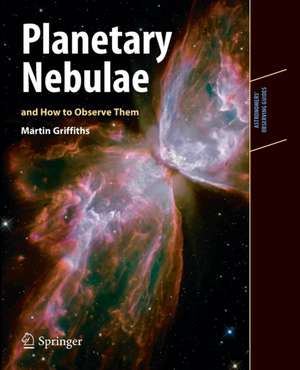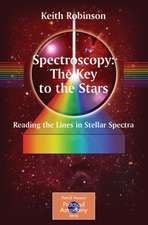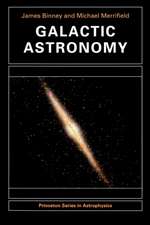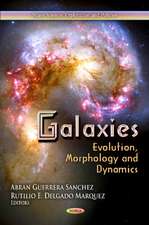Planetary Nebulae and How to Observe Them: Astronomers' Observing Guides
Autor Martin Griffithsen Limba Engleză Paperback – mar 2012
Planetary nebulae are not visible to the naked eye, but they are a fascinating group of telescope objects. This guide enables a user equipped with an average-sized amateur telescope to get the best out of observing them. Topics covered include their astrophysical make-up, history of their discovery, classification and description, telescopes to use, filters, and observing techniques - in short everything anyone would need to know to successfully observe planetary nebulae.
The book describes the various forms these astronomical objects can take and explains why they are favorite targets for amateur observers. Descriptions of over 100 nebulae personally observed by the author using telescopes of various sizes are included in the book. Readers can create their own observing program or follow the list of these captivating objects, many of which are found within our own Milky Way Galaxy.
Din seria Astronomers' Observing Guides
-
 Preț: 183.23 lei
Preț: 183.23 lei -
 Preț: 196.41 lei
Preț: 196.41 lei -
 Preț: 189.37 lei
Preț: 189.37 lei -
 Preț: 193.12 lei
Preț: 193.12 lei -
 Preț: 184.28 lei
Preț: 184.28 lei -
 Preț: 329.89 lei
Preț: 329.89 lei -
 Preț: 273.58 lei
Preț: 273.58 lei -
 Preț: 275.79 lei
Preț: 275.79 lei -
 Preț: 280.19 lei
Preț: 280.19 lei -
 Preț: 254.46 lei
Preț: 254.46 lei -
 Preț: 251.37 lei
Preț: 251.37 lei -
 Preț: 213.79 lei
Preț: 213.79 lei -
 Preț: 254.90 lei
Preț: 254.90 lei -
 Preț: 298.02 lei
Preț: 298.02 lei -
 Preț: 217.51 lei
Preț: 217.51 lei -
 Preț: 300.37 lei
Preț: 300.37 lei -
 Preț: 270.70 lei
Preț: 270.70 lei -
 Preț: 345.09 lei
Preț: 345.09 lei -
 Preț: 342.13 lei
Preț: 342.13 lei -
 Preț: 246.30 lei
Preț: 246.30 lei -
 Preț: 256.78 lei
Preț: 256.78 lei -
 Preț: 210.90 lei
Preț: 210.90 lei
Preț: 285.68 lei
Nou
Puncte Express: 429
Preț estimativ în valută:
54.66€ • 57.07$ • 45.24£
54.66€ • 57.07$ • 45.24£
Carte disponibilă
Livrare economică 14-28 martie
Preluare comenzi: 021 569.72.76
Specificații
ISBN-13: 9781461417811
ISBN-10: 1461417813
Pagini: 224
Ilustrații: XV, 287 p. 347 illus., 55 illus. in color.
Dimensiuni: 177 x 235 x 20 mm
Greutate: 0.57 kg
Ediția:2012
Editura: Springer
Colecția Springer
Seria Astronomers' Observing Guides
Locul publicării:New York, NY, United States
ISBN-10: 1461417813
Pagini: 224
Ilustrații: XV, 287 p. 347 illus., 55 illus. in color.
Dimensiuni: 177 x 235 x 20 mm
Greutate: 0.57 kg
Ediția:2012
Editura: Springer
Colecția Springer
Seria Astronomers' Observing Guides
Locul publicării:New York, NY, United States
Public țintă
Popular/generalCuprins
Part 1: What are Planetary Nebulae?.- Classification and Data.- Part 2: Telescopes and Techniques.- Photography Planetary Nebulae.- Observers' Guide.
Recenzii
From the reviews:
“This is a welcome addition to the literature … . chapters discuss the history, discovery, and evolution of planetary nebulae. … these are well written and give a comprehensive and up-to-date account of the current ideas on planetary-nebula formation. … descriptions are largely accurate and the photographs have generally reproduced well. … A useful and comprehensive list of further reading covering many aspects of planetary nebulae is included … . this is a useful guide to observing these ‘butterflies’ of the night sky … .” (Stewart Moore, The Observatory, Vol. 132 (1231), December, 2012)
“This book follows the standard pattern of the ‘… and how to Observe Them’ series with a brief section on the discovery of planetary nebulae followed by a section on how they form. … The book contains two chapters on observing techniques. … The book ends with a bibliography that is fairly extensive … . Planetary nebulae are some of the most popular objects that deep sky observers look for so … this is a decent first guide to observing these fascinating objects.” (Owen Brazell, Astronomy Now, August, 2012)
“This is a welcome addition to the literature … . chapters discuss the history, discovery, and evolution of planetary nebulae. … these are well written and give a comprehensive and up-to-date account of the current ideas on planetary-nebula formation. … descriptions are largely accurate and the photographs have generally reproduced well. … A useful and comprehensive list of further reading covering many aspects of planetary nebulae is included … . this is a useful guide to observing these ‘butterflies’ of the night sky … .” (Stewart Moore, The Observatory, Vol. 132 (1231), December, 2012)
“This book follows the standard pattern of the ‘… and how to Observe Them’ series with a brief section on the discovery of planetary nebulae followed by a section on how they form. … The book contains two chapters on observing techniques. … The book ends with a bibliography that is fairly extensive … . Planetary nebulae are some of the most popular objects that deep sky observers look for so … this is a decent first guide to observing these fascinating objects.” (Owen Brazell, Astronomy Now, August, 2012)
Notă biografică
Martin Griffiths is an enthusiastic science communicator, writer, and professional astronomer. Over his career he has utilized history, astronomy and science fiction as tools to encourage greater public understanding of science. He is a recipient of the Astrobiology Society of Britain's Public Outreach Award (2008) and the Astronomical League's Outreach Master Award (2010). He also holds the League's Master Observer certificate and has written or contributed to over 100 published science articles for many journals.
He was one of the founder members of NASA's Astrobiology Institute Science Communication Group, which was active between 2003 and 2006; he also managed a multi-million pound ESF program in Astrobiology for adult learners across Wales between 2003 and 2008. Since then he has been involved in promoting adult education, assisting in the development of a new observational astronomy award at the University of Glamorgan and various other projects, including initial consultation on the setup of an observatory in Andalucía, Spain. He is a consultant to the Welsh government through his involvement with the Dark Sky Discovery initiative, enabling public access to dark sky sites in association with Dark Sky Wales, Dark Sky Scotland and Natural England.
Martin is a Fellow of the Royal Astronomical Society and a member of the Astrobiology Society of Britain, the European Society for the History of Science, the British Astronomical Association, the British Science Association, the Webb Deep-Sky Society, the Society for Popular Astronomy, and the Astronomical League. He is also a local representative for the BAA Campaign for Dark Skies and is a member of the Honorable Society of Cymmrodorion, dedicated to promoting the literature, science and arts of Wales.
He was one of the founder members of NASA's Astrobiology Institute Science Communication Group, which was active between 2003 and 2006; he also managed a multi-million pound ESF program in Astrobiology for adult learners across Wales between 2003 and 2008. Since then he has been involved in promoting adult education, assisting in the development of a new observational astronomy award at the University of Glamorgan and various other projects, including initial consultation on the setup of an observatory in Andalucía, Spain. He is a consultant to the Welsh government through his involvement with the Dark Sky Discovery initiative, enabling public access to dark sky sites in association with Dark Sky Wales, Dark Sky Scotland and Natural England.
Martin is a Fellow of the Royal Astronomical Society and a member of the Astrobiology Society of Britain, the European Society for the History of Science, the British Astronomical Association, the British Science Association, the Webb Deep-Sky Society, the Society for Popular Astronomy, and the Astronomical League. He is also a local representative for the BAA Campaign for Dark Skies and is a member of the Honorable Society of Cymmrodorion, dedicated to promoting the literature, science and arts of Wales.
Textul de pe ultima copertă
Astronomers' Observing Guides provide up-to-date information for amateur astronomers who want to know all about what is it they are observing. This is the basis of the first part of the book. The second part details observing techniques for practical astronomers, working with a range of different instruments.
Planetary Nebulae and How to Observe Them is intended for amateur astronomers who want to concentrate on one of the most beautiful classes of astronomical objects in the sky. This book will help the observer to see these celestial phenomena using telescopes of various apertures.
As a Sun-like star reaches the end of its life, its hydrogen fuel starts to run out. It collapses until helium nuclei begin nuclear fusion, whereupon the star begins to pulsate, each pulsation throwing off a layer of the star's atmosphere. Eventually the atmosphere has all been ejected as an expanding cloud of gas, the star's core is exposed and ultraviolet photons cause the shell of gas to glow brilliantly - that's planetary nebula.
Topics covered in this book include the astrophysical makeup of planetary nebulae, a history of their discovery, classification and description, telescopes, filters and observing techniques - in short everything anyone would need to observe planetary nebulae.
A special feature of this book is the inclusion of over 100 nebulae in our Milky Way Galaxy personally observed by the author using telescopes of various sizes, enabling readers to make up their own observing program or to follow the authors program. The guide also includes photographs by the author of each object for ease of identification along with their celestial coordinates, magnitudes and other pertinent information.
Here is a volume that should be a welcome addition to any amateur astronomer's personal library, observing course, or school. With it in hand, you can begin sampling right away some of the most captivating objects in thesky.
body>
Planetary Nebulae and How to Observe Them is intended for amateur astronomers who want to concentrate on one of the most beautiful classes of astronomical objects in the sky. This book will help the observer to see these celestial phenomena using telescopes of various apertures.
As a Sun-like star reaches the end of its life, its hydrogen fuel starts to run out. It collapses until helium nuclei begin nuclear fusion, whereupon the star begins to pulsate, each pulsation throwing off a layer of the star's atmosphere. Eventually the atmosphere has all been ejected as an expanding cloud of gas, the star's core is exposed and ultraviolet photons cause the shell of gas to glow brilliantly - that's planetary nebula.
Topics covered in this book include the astrophysical makeup of planetary nebulae, a history of their discovery, classification and description, telescopes, filters and observing techniques - in short everything anyone would need to observe planetary nebulae.
A special feature of this book is the inclusion of over 100 nebulae in our Milky Way Galaxy personally observed by the author using telescopes of various sizes, enabling readers to make up their own observing program or to follow the authors program. The guide also includes photographs by the author of each object for ease of identification along with their celestial coordinates, magnitudes and other pertinent information.
Here is a volume that should be a welcome addition to any amateur astronomer's personal library, observing course, or school. With it in hand, you can begin sampling right away some of the most captivating objects in thesky.
body>
Caracteristici
Enables a user equipped with an average-sized amateur telescope to get the best out of observing beautiful objects in the night sky Details the astrophysical make-up, history, discovery, and classification of planetary nebulae Includes an observational guide of over 100 nebulae personally observed by the author with telescopes of various sizes Includes supplementary material: sn.pub/extras












